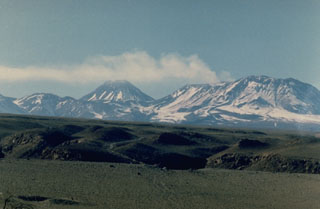Report on Lascar (Chile) — March 1989
Scientific Event Alert Network Bulletin, vol. 14, no. 3 (March 1989)
Managing Editor: Lindsay McClelland.
Lascar (Chile) Apparent new lava dome; gas and ash emission
Please cite this report as:
Global Volcanism Program, 1989. Report on Lascar (Chile) (McClelland, L., ed.). Scientific Event Alert Network Bulletin, 14:3. Smithsonian Institution. https://doi.org/10.5479/si.GVP.SEAN198903-355100
Lascar
Chile
23.37°S, 67.73°W; summit elev. 5592 m
All times are local (unless otherwise noted)
. . . Paul King climbed the volcano in February 1989 and saw what appeared to be an active lava dome in the summit crater. Gas emission was vigorous, but no glow was visible from Toconao, ~30 km from the volcano.
During observations by M. Gardeweg and Adrian Jones 23 March-1 April 1989, irregular, dominantly steam emissions were continuously released from the N part of the E cone of this composite of two andesitic cones. Columns rose 400-600 m above the cone and plumes extended SE, with occasional fine-grained fallout. Observation from the SE flank on 26 March showed the steam to include sulfurous gas and light ash, which was being deposited on the E flank. A 1-m bomb in a fresh crater 4 m in diameter, 3 km S of the active summit, must have been erupted within recent months, although there are no reports of an eruption. The regular activity was interrupted for one day (29 March) by a change from emission of voluminous dense steam to light, translucent gas visible only near the summit.
Geological Summary. Láscar is the most active volcano of the northern Chilean Andes. The andesitic-to-dacitic stratovolcano contains six overlapping summit craters. Prominent lava flows descend its NW flanks. An older, higher stratovolcano 5 km E, Volcán Aguas Calientes, displays a well-developed summit crater and a probable Holocene lava flow near its summit (de Silva and Francis, 1991). Láscar consists of two major edifices; activity began at the eastern volcano and then shifted to the western cone. The largest eruption took place about 26,500 years ago, and following the eruption of the Tumbres scoria flow about 9000 years ago, activity shifted back to the eastern edifice, where three overlapping craters were formed. Frequent small-to-moderate explosive eruptions have been recorded since the mid-19th century, along with periodic larger eruptions that produced ashfall hundreds of kilometers away. The largest historical eruption took place in 1993, producing pyroclastic flows to 8.5 km NW of the summit and ashfall in Buenos Aires.
Information Contacts: M. Gardeweg, SERNAGEOMIN, Santiago; A. Jones, Kingston Polytechnic, Surrey UK; P. King, Minsal Co., Toconao, Chile; P. Francis, Lunar & Planetary Institute, Houston.

